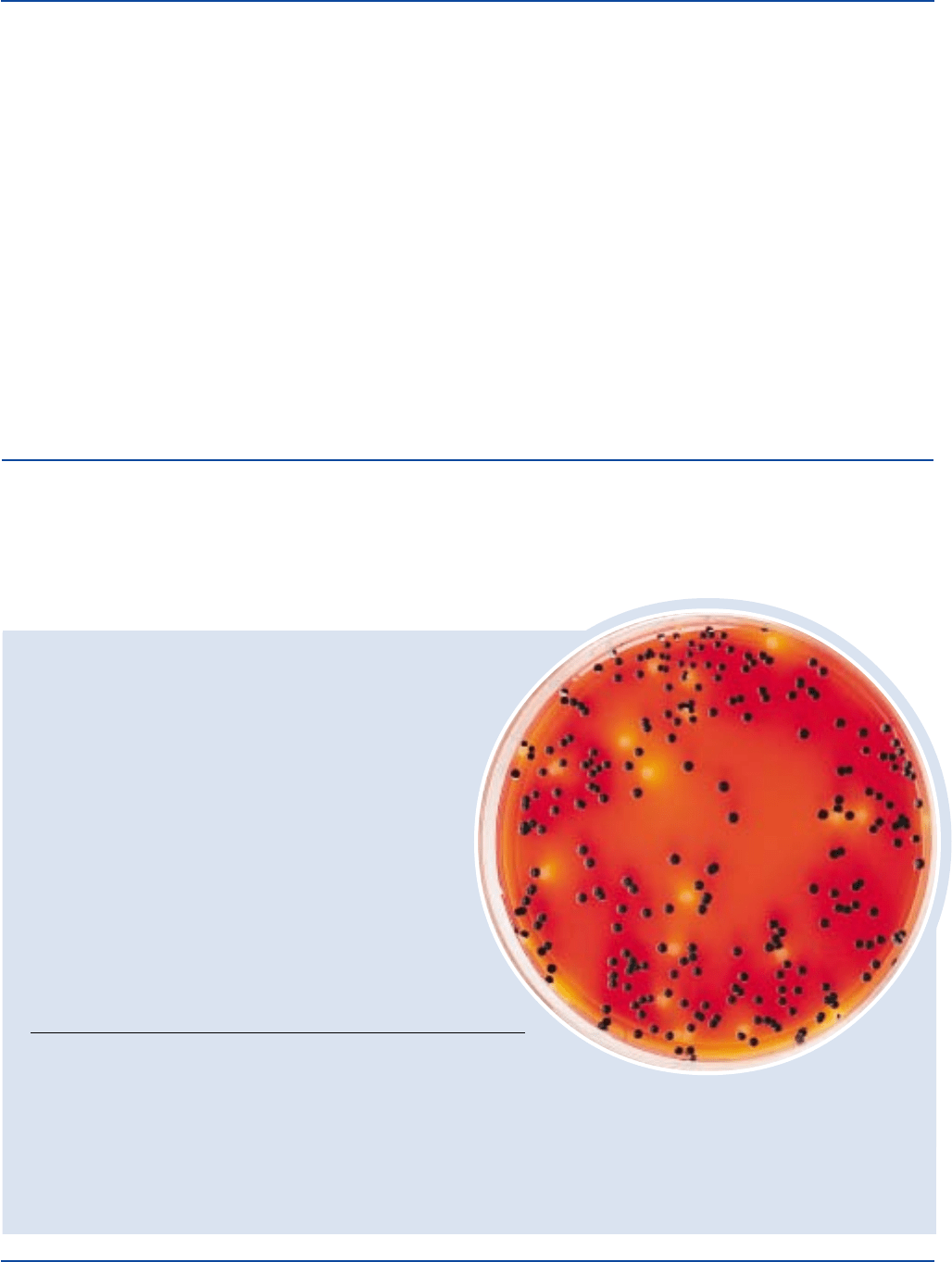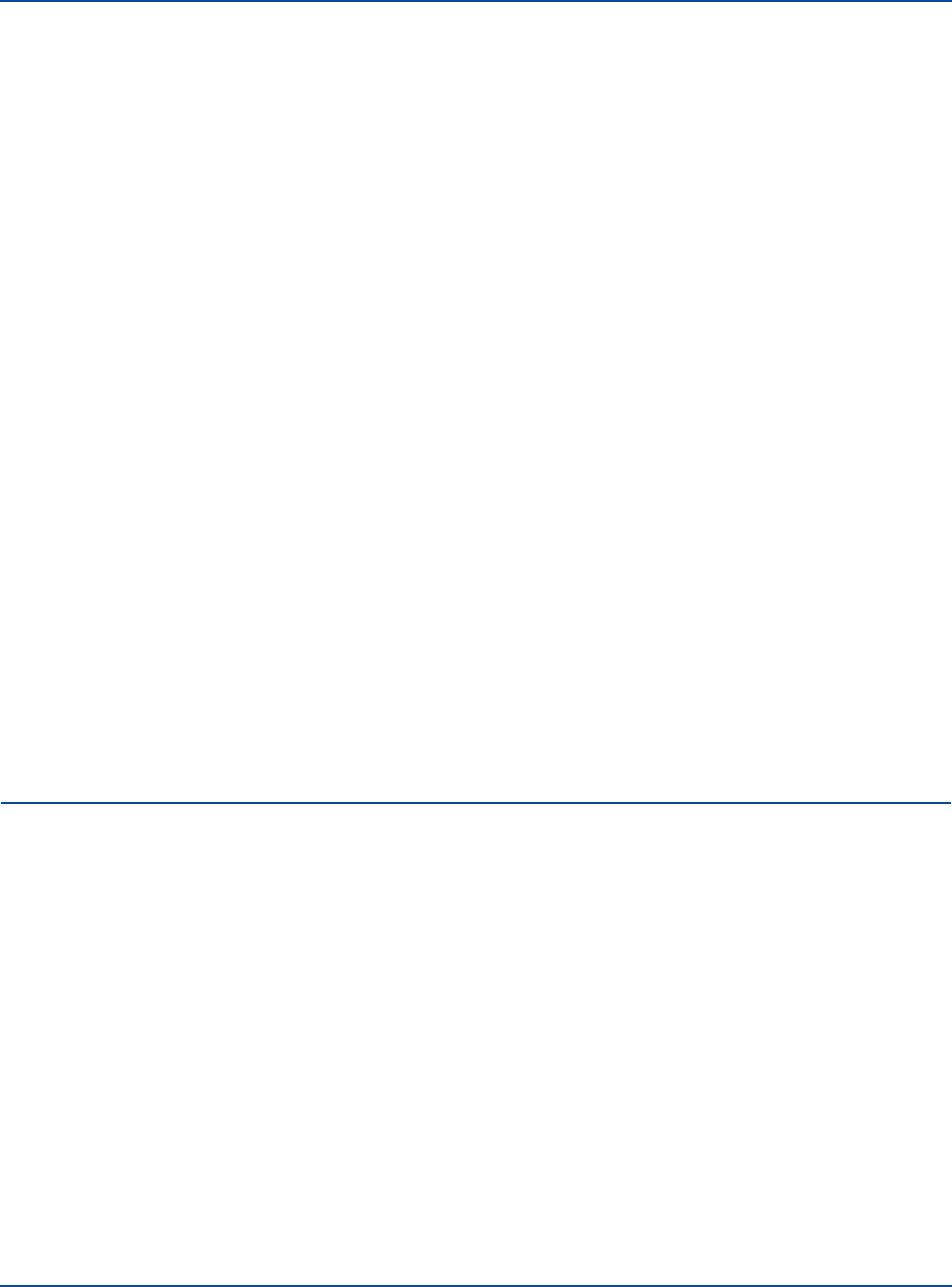BD Diagnostic Systems (publ.). Difco Manual (Manual of Microbiological Culture)
Подождите немного. Документ загружается.


566 The Difco Manual
XLD Agar
Formula Per Liter
Bacto Yeast Extract . . . . . . . . . . . . . . . . . . . . . . . . . . . . . . . . 3 g
L-Lysine . . . . . . . . . . . . . . . . . . . . . . . . . . . . . . . . . . . . . . . . 5 g
Bacto Xylose . . . . . . . . . . . . . . . . . . . . . . . . . . . . . . . . . . . 3.75 g
Bacto Lactose . . . . . . . . . . . . . . . . . . . . . . . . . . . . . . . . . . . 7.5 g
Bacto Saccharose . . . . . . . . . . . . . . . . . . . . . . . . . . . . . . . . 7.5 g
Sodium Desoxycholate . . . . . . . . . . . . . . . . . . . . . . . . . . . . 2.5 g
Ferric Ammonium Citrate . . . . . . . . . . . . . . . . . . . . . . . . . 0.8 g
Sodium Thiosulfate. . . . . . . . . . . . . . . . . . . . . . . . . . . . . . . 6.8 g
Sodium Chloride . . . . . . . . . . . . . . . . . . . . . . . . . . . . . . . . . . 5 g
Bacto Agar . . . . . . . . . . . . . . . . . . . . . . . . . . . . . . . . . . . . . 15 g
Bacto Phenol Red . . . . . . . . . . . . . . . . . . . . . . . . . . . . . . . 0.08 g
Final pH 7.4 ± 0.2 at 25°C
Precautions
1. For Laboratory Use.
2. XLD Agar:
IRRITANT. IRRITATING TO EYES, RESPIRATORY SYSTEM
AND SKIN. Avoid contact with skin and eyes. Do not breathe dust.
Wear suitable protective clothing. Keep container tightly closed.
FIRST AID: In case of contact with eyes, rinse immediately with
plenty of water and seek medical advice. After contact with skin,
wash immediately with plenty of water. If inhaled, remove to fresh
air. If not breathing, give artificial respiration. If breathing is
difficult, give oxygen. Seek medical advice. If swallowed seek
medical advice immediately and show this container or label.
3. Follow proper established laboratory procedures in handling and
disposing of infectious materials.
Storage
Store the dehydrated media below 30°C. The dehydrated medium is
very hygroscopic. Keep container tightly closed.
Expiration Date
The expiration date applies to the product in its intact container when
stored as directed. Do not use a product if it fails to meet specifications
for identity and performance.
Procedure
Materials Provided
XL Agar Base
XLD Agar
Materials Required But Not Provided
Glassware
Autoclave
Incubator
Petri dishes
34% sodium thiosulfate, sterile (XL Agar)
4% ferric ammonium citrate, sterile (XL Agar)
1% brilliant green (XLBG)
Method of Preparation
XL Agar Base
1. Suspend 47 grams in 1 liter distilled or deionized water.
(OPTIONAL: To prepare XLBG Agar, add 1.25 ml aqueous
1% solution of brilliant green.)
2. Heat to boiling to dissolve completely.
3. Autoclave at 121°C for 15 minutes.
3. Cool to 55-60°C.
4. Aseptically add 20 ml sterile aqueous 34% solution of sodium
thiosulfate and 4% solution of ferric ammonium citrate.
Mix thoroughly.
5. Dispense as desired.
XLD Agar
1. Suspend 57 grams in 1 liter distilled or deionized water.
2. Heat to boiling to dissolve completely. Avoid overheating.
DO NOT AUTOCLAVE.
3. Cool to 55-60°C. Dispense as desired.
Specimen Collection and Preparation
XLD Agar is listed in several procedures as a plating medium for the
testing of food samples.
8,9,10,11
Refer to the appropriate references
regarding specimen preparation.
Test Procedure
Feces or rectal swabs may be plated directly; selective enrichment
broths, such as Selenite Broth or Tetrathionate Broth, may be used prior
to streaking.
5,6,7
Results
Degradation of xylose, lactose and sucrose generates acid products,
causing a color change in the medium from red to yellow.
Hydrogen sulfide production under alkaline conditions causes
colonies to develop black centers. This reaction is inhibited by the acid
conditions that accompany carbohydrate fermentation.
Lysine decarboxylation in the absence of lactose and sucrose
fermentation causes reversion to an alkaline condition and the color of
the medium changes back to red.
Limitations of the Procedure
1. Red, false-positive colonies may occur with some Proteus and
Pseudomonas species.
2. Incubation in excess of 48 hours may lead to false-positive results.
3. S. paratyphi A, S. choleraesuis, S. pullorum and S. gallinarum
may form red colonies without black centers, thus resembling
Shigella species.
4. Some Proteus strains will give black-centered colonies on XLD
Agar.
References
1. Taylor, W. I. 1965. Isolation of shigellae. I. Xylose lysine agars;
new media for isolation of enteric pathogens. Am. J. Clin. Pathol.
44(4):471-475.
2. Rollender, W., O. Beckford, R. D. Belsky, and B. Kostroff. 1969.
Comparison of xylose lysine deoxycholate agar and MacConkey
agar for the isolation of Salmonella and Shigella from clinical
specimens. Tech. Bull. Reg. Med. Tech. 39(1):8-10.
3. Pollock, H. M., and B. J. Dahlgren. 1974. Clinical evaluation of
enteric media in the primary isolation of Salmonella and Shigella.
Appl. Microbiol. 27(1):197-201.
XL Agar Base & XLD Agar Section II

The Difco Manual 567
4. Bhat, P., and D. Rajan. 1975. Comparative evaluation of
desoxycholate citrate medium and xylose lysine desoxycholate
medium in the isolation of shigellae. Am. J. Clin. Pathol. 64:399-404.
5. MacFaddin, J. F. 1985. Media for isolation-cultivation-
identification-maintenance of medical bacteria, vol. 1. Williams
& Wilkins, Baltimore, MD.
6. Murray, P. R., E. J. Baron, M. A. Pfaller, F. C. Tenover, and
R. H. Yolken (ed.). 1995. Manual of clinical microbiology, 6th ed.
American Society for Microbiology, Washington, D.C.
7. United States Pharmacopeial Convention. 1995. The United
States pharmacopeia, 23rd ed. The United States Pharmacopeial
Convention, Rockville, MD.
8. Smith, J. L., and R. L. Buchanan. 1992. Shigella, p. 423-431. In
C. Vanderzant and D. F. Splittstoesser (ed.), Compendium of
methods for the microbiological examination of food, 3rd ed.
American Public Health Association, Washington, D.C.
9. Flowers, R. S., W. Andrews, C. W. Donnelly, and E. Koenig.
1993. Pathogens in milk and milk products, p. 103-212. In R. T.
Marshall, (ed.), Standard methods for the examination of dairy
products, 16th ed. American Public Health Association,
Washington, D.C.
10. Andrews, W. H., G. A. June, P. S. Sherrod, T. S. Hammack,
and R. M. Amaguana. 1995. Salmonella, p. 5.01-5.20. In
Bacteriological Analytical Manual, 8th ed. AOAC International,
Gaithersburg, MD.
11. Association of Official Analytical Chemists. 1996. Official
methods of analysis of AOAC International, Supplement March
1996. AOAC International, Arlington, VA.
Packaging
XL Agar Base 500 g 0555-17
XLD Agar 100 g 0788-15
500 g 0788-17
2 kg 0788-07
10 kg 0788-08
Section II XLT4 Agar Base & XLT4 Agar Supplement
Bacto
®
XLT4 Agar Base
Bacto XLT4 Agar Supplement
User Quality Control
Identity Specifications
Dehydrated Appearance: Pink, free flowing, homogeneous.
Base Solution: 5.9% solution; soluble in distilled or
deionized water on boiling. Solution is
red, very slightly to slightly opalescent.
XLT4 Agar Supplement: Colorless to slightly yellow, clear,
slightly viscous solution.
Prepared Medium: Reddish-orange, very slightly to
slightly opalescent.
Reaction of Final
Medium at 25°C: pH 7.4 ± 0.2
Cultural Response
Prepare XLT4 Agar per label directions. Inoculate and incubate
at 35 ± 2°C for 18-48 hours.
INOCULUM COLONIAL
ORGANISM ATCC
®
CFU GROWTH MORPHOLOGY
Enterococcus faecalis 29212* 1,000 markedly inhibited –
Escherichia coli 25922* 1,000 partially inhibited yellow colonies
Proteus mirabilis 25933 1,000 inhibited –
Salmonella typhimurium 14028* 100-1,000 good yellow to red colonies
with black centers
Staphylococcus aureus 25923* 1,000 inhibited –
Salmonella typhimurium
ATCC
®
14028
on XLT4 Agar Base with XLT4 Supplement
The cultures listed are the minimum that should be used for performance testing.
*These cultures are available as Bactrol
™
Disks and should be used as directed in Bactrol Disks Technical Information.
Intended Use
Bacto XLT4 Agar Base is used with Bacto XLT4 Agar Supplement in
isolating non-typhi Salmonella.

568 The Difco Manual
Summary and Explanation
Numerous media have been developed for isolating and differentiating
enteric pathogens. The majority were designed to recover a broad
spectrum of enteric pathogens.
1
Consequently, overgrowth of nuisance
or contaminating organisms can be a major problem when recovery of
a specific organism or species is desired. This is particularly true for
Salmonella isolation media where overgrowth of Proteus, Providencia
and Pseudomonas can dramatically interfere with the detection and
isolation of Salmonella.
In 1990, Miller and Tate described a new medium, XLT4 Agar, for
isolating Salmonella.
1
The authors established the selectivity of XLT4
Agar using pure cultures of a variety of enteric organisms. They also
evaluated its sensitivity in detecting and isolating Salmonella using
fecal-contaminated farm samples containing high numbers of competing
bacteria. In follow-up studies, Miller
2,3
and Tate
4
reported that XLT4
Agar significantly improved the recovery of non-typhi Salmonella from
chicken and farm environmental drag-swab samples.
XLT4 Agar can be used clinically to screen stool samples for non-
typhoid Salmonella.
5,6
Principles of the Procedure
XLT4 Agar Base contains Proteose Peptone No. 3 as a source of complex
nitrogen compounds. Yeast Extract is added as a source of vitamins
and other cofactors. Differentiation of Salmonella from other organisms
that also grow on this medium is based on fermentation of Xylose,
Lactose and Sucrose, decarboxylation of Lysine, and the production of
hydrogen sulfide. Hydrogen sulfide production is detected by the addition
of ferric ions. Sodium Thiosulfate is added as a source of inorganic
sulfur. Sodium Chloride maintains the osmotic balance of the medium.
Bacto Agar is the solidifying agent. Phenol Red is added as an indicator
of pH changes resulting from fermentation and decarboxylation
reactions. XLT4 Agar Supplement is added to inhibit growth of
non-Salmonella organisms.
Formula
XLT4 Agar Base
Formula Per Liter
Bacto Proteose Peptone No. 3 . . . . . . . . . . . . . . . . . . . . . . 1.6 g
Bacto Yeast Extract . . . . . . . . . . . . . . . . . . . . . . . . . . . . . . . . 3 g
L-Lysine . . . . . . . . . . . . . . . . . . . . . . . . . . . . . . . . . . . . . . . . 5 g
Bacto Xylose . . . . . . . . . . . . . . . . . . . . . . . . . . . . . . . . . . . 3.75 g
Bacto Lactose . . . . . . . . . . . . . . . . . . . . . . . . . . . . . . . . . . . 7.5 g
Bacto Saccharose . . . . . . . . . . . . . . . . . . . . . . . . . . . . . . . . 7.5 g
Ferric Ammonium Citrate . . . . . . . . . . . . . . . . . . . . . . . . . 0.8 g
Sodium Thiosulfate. . . . . . . . . . . . . . . . . . . . . . . . . . . . . . . 6.8 g
Sodium Chloride . . . . . . . . . . . . . . . . . . . . . . . . . . . . . . . . . . 5 g
Bacto Agar . . . . . . . . . . . . . . . . . . . . . . . . . . . . . . . . . . . . . 18 g
Bacto Phenol Red . . . . . . . . . . . . . . . . . . . . . . . . . . . . . . . 0.08 g
Final pH 7.4 ± 0.2 at 25°C
XLT4 Agar Supplement
A 27% solution (approximate) of the surfactant 7-ethyl-2-methyl-4-undecanol
hydrogen sulfate, sodium salt, formerly produced by Union Carbide under
the tradename of Tergitol 4.
Precautions
1. For Laboratory Use.
2. XLT4 Agar Base
IRRITANT. IRRITATING TO EYES, RESPIRATORY SYSTEM
AND SKIN. Avoid contact with skin and eyes. Do not breathe dust.
Wear suitable protective clothing. Keep container tightly closed.
FIRST AID: In case of contact with eyes, rinse immediately with
plenty of water and seek medical advice. After contact with skin,
wash immediately with plenty of water. If inhaled, remove to fresh
air. If not breathing, give artificial respiration. If breathing is diffi-
cult, give oxygen. Seek medical advice. If swallowed seek medical
advice immediately and show this container or label.
XLT4 Agar Supplement
CORROSIVE. CAUSES BURNS. HARMFUL BY INHALA-
TION, IN CONTACT WITH SKIN AND IF SWALLOWED. Avoid
contact with skin and eyes. Do not breathe mist. Wear suitable
protective clothing, gloves and eye/face protection. Keep container
tightly closed.
FIRST AID: In case of contact with eyes, rinse immediately with
plenty of water and seek medical advice. After contact with skin,
wash immediately with plenty of water. If inhaled, remove to fresh
air. If not breathing, give artificial respiration. If breathing is diffi-
cult, give oxygen. Seek medical advice. If swallowed seek medical
advice immediately and show this container or label.
3. Follow proper established laboratory procedure in handling and
disposing of infectious materials.
Storage
Store XLT4 Agar Base below 30°C. The dehydrated medium is very
hygroscopic. Keep container tightly closed. Store prepared medium
at 2-8°C.
Store XLT4 Agar Supplement at 15-30°C.
Expiration Date
The expiration date applies to the product in its intact container when
stored as directed. Do not use a product if it fails to meet specifications
for identity and performance.
Procedure
Materials Provided
XLT4 Agar Base
XLT4 Agar Supplement
Materials Required But Not Provided
Flasks with closures
Distilled or deionized water
Bunsen burner or magnetic hot plate
Waterbath (45-50°C)
Petri dishes
Incubator (35°C)
Method of Preparation
1. Suspend 59 grams of XLT4 Agar Base in 1 liter distilled or
deionized water.
2. Add 4.6 ml XLT4 Agar Supplement.
3. Heat to boiling to dissolve completely. Avoid overheating. DO
NOT AUTOCLAVE. Cool to 45-50°C in a waterbath.
4. Dispense into sterile Petri dishes.
Specimen Collection and Preparation
1. Collect specimens in sterile containers or with sterile swabs and
transport immediately to the laboratory following recommended
guidelines.
7-10
XLT4 Agar Base & XLT4 Agar Supplement Section II

The Difco Manual 569
2. Process each specimen, using procedures appropriate for that
sample.
7,8,10,11
Test Procedure
1. Inoculate a suitable Salmonella enrichment broth (such as
Tetrathionate Broth) and incubate at 35°C for 18-24 hours.
2. Following enrichment, subculture onto XLT4 Agar. Streak for
isolation.
3. Incubate plates aerobically at 35 ± 2°C. Examine for growth after
18-24 and 48 hours incubation.
Results
Typical Salmonella colonies (H
2
S-positive) appear black or black-
centered with a yellow periphery after 18-24 hours of incubation. Upon
continued incubation, the colonies become entirely black or pink to
red with black centers.
Colonies of H
2
S-negative Salmonella strains appear pinkish-yellow.
Most Citrobacter colonies that grow on this medium are yellow without
evidence of blackening. Growth of Enterobacter aerogenes and
Escherichia coli is markedly inhibited; colonies that do grow appear
yellow without evidence of blackening. Growth of Proteus,
Pseudomonas, Providencia, Alteromonas putrefaciens, Yersinia
enterocolitica and Acinetobacter calcoaceticus is markedly to
completely inhibited on XLT4 Agar. Shigella species are partially
inhibited and colonies appear red.
Limitations of the Procedure
1. XLT4 Agar is intended for detecting and isolating Salmonella based
on selectivity and colonial characteristics. Presumed Salmonella
colonies must be confirmed by biochemical and/or immunological
methods. Consult appropriate references for further information.
5,7,8,12
2. Since the nutritional requirements of organisms vary, some strains
of Salmonella may be encountered that fail to grow or grow poorly
on this medium.
3. Non-Salmonella strains that are not completely inhibited on this
medium may be encountered and must be differentiated from
Salmonella. Consult appropriate references.
7,8,10,12
4. Freshly inoculated plates and plates held over several days may
develop multicolored, metallic looking crystals/flecks on the
surface. These crystals/flecks do not interfere with the performance
of the medium.
References
1. Miller, R. G., and C. R. Tate. 1990. XLT4: A highly selective
plating medium for the isolation of Salmonella. The Maryland
Poultryman April:2-7.
2. Miller, R. G., C. R. Tate, E. T. Mallinson, and J. A. Schemer.
1991. Xylose-Lysine-Tergitol 4: An improved selective agar medium
for the isolation of Salmonella. Poultry Science 70:2429-2432.
3. Miller, R. G., C. R. Tate, E. T. Mallinson, and J. A. Schemer.
1992. Erratum. Xylose-Lysine-Tergitol 4: An improved selective
agar medium for the isolation of Salmonella. Poultry Science
71:398.
4. Tate, C. R., R. G. Miller, and E. T. Mallinson. 1992. Evaluation
of two isolation and two non-isolation methods for detecting
naturally occurring salmonellae from broiler flock environmental
drag-swab samples. J. Food Prot. 55:964-967.
5. Dusch, H., and M. Altwegg. 1994. Evaluation of Xylose-Lysine-
Tergitol 4 (XLT4) Agar and Modified Semisolid Rappaport
Vassiliadis (MSRV) Medium for the isolation of non-typhoid
salmonellae from stool samples. Abstr. Annu. Meet. Am. Soc.
Microbiol. C5:557.
6. Dusch, H., and M. Altwegg. 1995. Evaluation of five new plating
media for the isolation of Salmonella species. J. Clin. Microbiol.
33:802-804.
7. Andrews, W. H., G. A. June, P. S. Sherrod, T. S. Hammack,
and R. M. Amaguana. 1995. Salmonella. In FDA Bacteriological
analytical manual, 8th ed. AOAC International, Arlington, VA.
8. Vanderzant, C., and D. F. Splittstoesser (ed.) 1992. Compen-
dium of methods for the microbiological examination of foods,
3rd ed. American Public Health Association, Washington, D.C.
9. Miller, J. M., and H. T. Holmes. 1995. Specimen collection,
transport, and storage, p. 19-31. In P. R. Murray, et al. (ed). Manual of
clinical microbiology, 6th ed. American Society for Microbiology,
Washington, D.C.
10. Pezzlo, Marie (ed). 1992. Aerobic bacteria. In H. D. Isenberg (ed),
Clinical microbiology procedures handbook, vol. 1. American
Society for Microbiology, Washington, D.C.
11. Forbes, B. A., and P. A. Granato. 1995. Processing specimens for
bacteria, p. 265-281. In P. R. Murray, et al. (ed), Manual of clinical
microbiology, 6th ed. American Society for Microbiology, Wash-
ington, D.C.
12. Gray, L. D. 1995. Escherichia, Salmonella, Shigella and Yersinia.
In P. R. Murray, et al. (ed), Manual of clinical microbiology, 6th
ed. American Society for Microbiology, Washington, D.C.
Packaging
XLT4 Agar Base 500 g 0234-17
XLT4 Agar Supplement l00 ml 0353-72
Section II YM Agar & YM Broth
Bacto
®
YM Agar
Bacto YM Broth
Intended Use
Bacto YM Agar and YM Broth are used for cultivating yeasts, molds
and other aciduric microorganisms.
Also Known As
YM is an abbreviation for Yeast Extract and Malt Extract.
Summary and Explanation
YM Agar and YM Broth are prepared according to the formulation
published by Wickerham.
1,2,3
Wickerham suggested that YM Broth
acidified to pH 3.0-4.0 be used as an enrichment medium for
yeasts from populations also containing bacteria and molds. To favor
isolation of fermentative species, add a layer of sterile paraffin oil

570 The Difco Manual
User Quality Control
Identity Specifications
YM Agar
Dehydrated Appearance: Beige, free-flowing, homogeneous.
Solution: 4.1% solution, soluble in distilled or
deionized water on boiling. Solution
is light to medium amber, very
slightly opalescent, without
significant precipitate.
Prepared Plates: Light to medium amber, slightly
opalescent without precipitate.
Reaction of 4.1%
Solution at 25°C: pH 6.2 ± 0.2
YM Broth
Dehydrated Appearance: Light beige, free-flowing, homogeneous.
Solution: 2.1% solution, soluble in distilled or
deionized water. Solution is light to
medium amber, clear to very slightly
opalescent without significant
precipitate.
NOTE: At pH adjusted to 3.0-4.0, medium
becomes slightly opalescent.
Prepared Tubes: Light - medium amber, clear to very
slightly opalescent without significant
precipitate.
Reaction of 2.1%
Solution at 25°C: pH 6.2 ± 0.2
Cultural Response
Prepare 2 sets of YM Agar plates or YM Broth tubes (one set
pH 6.2, one set adjusted to pH 3.0-4.0) per label directions.
Inoculate and incubate at 30 ± 2°C for 18-72 hours.
INOCULUM GROWTH GROWTH
ORGANISM ATCC
®
CFU PH 3.0-4.0 PH 6.2
Aspergillus niger 16404 100-1,000 good good
Candida albicans 10231 100-1,000 good good
Escherichia coli 25922* 100-1,000 markedly to good
completely inhibited
Lactobacillus casei 7469 100-1,000 poor to fair good
Saccharomyces
cerevisiae 9763 100-1,000 good good
The cultures listed are the minimum that should be used for
performance testing.
*These cultures are available as Bactrol
™
Disks and should be used
as directed in Bactrol Disks Technical Information.
YM Agar & YM Broth Section II
1 cm deep on the surface of the inoculated broth. Incubate the culture
until growth appears and then streak onto YM Agar to obtain isolated
yeast colonies. To isolate fermentative and oxidative strains, place
acidified inoculated YM Broth on a rotary shaker for 1 or 2 days. This
favors yeast recovery while preventing the sporulation of molds.
Media selectivity may be enhanced through acidification or through
addition of selective agents. YM Broth may be acidified prior to
sterilization. YM Agar should be sterilized without pH adjustment
and sterile acid added to the sterile molten medium cooled to
45-50°C. Acidified YM Agar should not be heated. Antibiotics may
be aseptically added to the sterile media. Other fungistatic materials,
such as sodium propionate and diphenyl may be added to YM Agar
to eliminate molds and permit the enumeration of yeasts to
mixed populations.
Principles of the Procedure
Yeast Extract is a source of trace elements, vitamins and amino acids.
Malt Extract is a source of carbon, protein and nutrients. Bacto Peptone
is an additional source of carbon and provides nitrogen and amino
acids. Dextrose provides carbon. Bacto Agar is a solidifying agent.
Formula
YM Agar
Formula Per Liter
Bacto Yeast Extract . . . . . . . . . . . . . . . . . . . . . . . . . . . . . . . . 3 g
Bacto Malt Extract . . . . . . . . . . . . . . . . . . . . . . . . . . . . . . . . 3 g
Bacto Peptone . . . . . . . . . . . . . . . . . . . . . . . . . . . . . . . . . . . . 5 g
Bacto Dextrose . . . . . . . . . . . . . . . . . . . . . . . . . . . . . . . . . . 10 g
Bacto Agar . . . . . . . . . . . . . . . . . . . . . . . . . . . . . . . . . . . . . 20 g
Final pH 6.2 ± 0.2 at 25°C
YM Broth
Formula Per Liter
Bacto Yeast Extract . . . . . . . . . . . . . . . . . . . . . . . . . . . . . . . . 3 g
Bacto Malt Extract . . . . . . . . . . . . . . . . . . . . . . . . . . . . . . . . 3 g
Bacto Peptone . . . . . . . . . . . . . . . . . . . . . . . . . . . . . . . . . . . . 5 g
Bacto Dextrose . . . . . . . . . . . . . . . . . . . . . . . . . . . . . . . . . . 10 g
Final pH 6.2 ± 0.2 at 25°C
Precautions
1. For Laboratory Use.
2. Follow proper established laboratory procedure in handling and
disposing of infectious materials.
Storage
Store dehydrated medium below 30°C. The dehydrated medium is very
hygroscopic. Keep container tightly closed.
Expiration Date
The expiration date applies to the product in its intact container when
stored as directed. Do not use a product if it fails to meet specifications
for identity and performance.
Procedure
Materials Provided
YM Agar
YM Broth
Materials Required but not Provided
Glassware
Autoclave
Antibiotics
Sterile 10% HCl, Tartaric Acid or 10% Citric Acid
Method of Preparation
YM Agar
1. Suspend 41 grams in 1 liter distilled or deionized water.
2. Heat to boiling to dissolve completely.
3. Autoclave at 121°C for 15 minutes. Cool to 45-50°C.
4. Dispense into sterile Petri dishes.

The Difco Manual 571
Section II YPD Agar & YPD Broth
YM Broth
1. Dissolve 21 grams in 1 liter distilled or deionized water.
2. Autoclave at 121°C for 15 minutes.
Optional (for Agar or Broth): If desired, acidify the medium
to pH 3.0-4.0 by adding sterile 10% HCl, Tartaric Acid or
10% Citric Acid. Selective agents, e.g., penicillin (20 units per ml
final concentration) or streptomycin (40 micrograms per ml final
concentration) may be added to the medium after sterilization
using aseptic technique.
Test Procedure
1. Inoculate YM Agar plates or YM Broth tubes with sample to evaluated
for the presence of yeasts, molds, or aciduric microorganisms.
2. Incubate at 30 ± 2°C for 18-72 hours.
Results
Examine the plates or tubes for growth. Record YM Agar results as
colony forming units (CFU) per volume of sample. Record YM Broth
results as growth or no growth.
Limitations of the Procedure
1. Acidified YM Agar should not be overheated.
References
1. 1951. U. S. Dept. Agricult. Tech. Bull. No. 1029.
2. 1939. J. Tropical Med. Hyg. 42:176.
3. Jong, S. C., and M. J. Edwards. 1991. American Type Culture
Collection Catalog of filamentous fungi, 18th ed. American Type
Collection, Rockville, MD.
Packaging
YM Agar 500 g 0712-17
YM Broth 500 g 0711-17
10 kg 0711-08
Bacto
®
YPD Agar
Bacto YPD Broth
User Quality Control
Identity Specifications
YPD Agar
Dehydrated Appearance: Beige, free-flowing, homogeneous.
Solution: 6.5% solution, soluble in distilled or
deionized water on boiling. Solution
is light to medium amber, very
slightly to slightly opalescent.
Prepared Medium: Light to medium amber, slightly
opalescent.
Reaction of 6.5%
Solution at 25°C: pH 6.5 ± 0.2
YPD Broth
Dehydrated Appearance: Beige, free-flowing, homogeneous.
Solution: 5.0% solution, soluble in distilled or
deionized water. Solution is light to
medium amber, clear to very slightly
opalescent.
Prepared Medium: Light to medium amber, clear to very
slightly opalescent.
Reaction of 5.0%
Solution at 25°C: pH 6.5 ± 0.2
Cultural Response
Prepare YPD Agar or YPD Broth per label directions. Inoculate
and incubate the plates or tubes at 25 ± 2°C for 42-48 hours.
INOCULUM
ORGANISM ATCC
®
CFU GROWTH
Kluyveromyces lactis 8563 100-1,000 good
Saccharomyces cerevisiae 18790 100-1,000 good
Saccharomyces pastorianus 9080 100-1,000 good
The cultures listed are the minimum that should be used for
performance testing.
Intended Use
Bacto YPD Agar and Bacto YPD Broth are used for maintaining and
propagating yeasts in molecular microbiology procedures.
Also Known As
YPD media are also known as Yeast Extract-Peptone-Glucose media
and may be abbreviated as YEPD.
Summary and Explanation
General methods in yeast genetics specify using yeast extract-
peptone-glucose (YPD) medium for cultivating Saccharomyces
cerevisiae and other yeasts.
1
Yeasts grow well on a minimal medium
containing only glucose and salts. The addition of protein and yeast
cell extract hydrolysates allow faster growth so that during exponential
or log-phase growth, the cells divide every 90 minutes.
1
Principles of the Procedure
YPD Agar and YPD Broth contain Bacto Peptone as a source of
carbon, nitrogen, vitamins and minerals. Yeast Extract supplies B-complex
vitamins which stimulate bacterial growth. Dextrose is the carbohydrate
source. YPD Agar contains Bacto Agar as the solidifying agent.
Formula
YPD Agar
Formula Per Liter
Bacto Yeast Extract . . . . . . . . . . . . . . . . . . . . . . . . . . . . . . . 10 g
Bacto Peptone . . . . . . . . . . . . . . . . . . . . . . . . . . . . . . . . . . . 20 g
Bacto Dextrose . . . . . . . . . . . . . . . . . . . . . . . . . . . . . . . . . . 20 g
Bacto Agar . . . . . . . . . . . . . . . . . . . . . . . . . . . . . . . . . . . . . 15 g
Final pH 6.5 ± 0.2 at 25°C
YPD Broth
Formula Per Liter
Bacto Yeast Extract . . . . . . . . . . . . . . . . . . . . . . . . . . . . . . . 10 g
Bacto Peptone . . . . . . . . . . . . . . . . . . . . . . . . . . . . . . . . . . . 20 g
Bacto Dextrose . . . . . . . . . . . . . . . . . . . . . . . . . . . . . . . . . . 20 g
Final pH 6.5 ± 0.2 at 25°C

572 The Difco Manual
Precautions
1. For Laboratory Use.
2. Follow proper established laboratory procedures in handling and
disposing of infectious materials.
Storage
Store the dehydrated medium below 30°C. The dehydrated medium is
very hygroscopic. Keep container tightly closed.
Expiration Date
The expiration date applies to the product in its intact container when
stored as directed. Do not use a product if it fails to meet specifications
for identity and performance.
Procedure
Materials Provided
YPD Agar
YPD Broth
Materials Required but not Provided
Glassware
Distilled or deionized water
Autoclave
Incubator (25°C)
Method of Preparation
YPD Agar
1. Suspend 65 grams of YPD Agar in 1 liter of distilled or deionized
water.
2. Heat to boiling to dissolve completely.
3. Autoclave at 121°C for 15 minutes.
YPD Broth
1. Suspend 50 grams in 1 liter distilled or deionized water.
2. Autoclave at 121°C for 15 minutes.
Specimen Collection and Preparation
Collect specimens according to recommended guidelines.
Test Procedure
See appropriate references for specific procedures.
Results
Growth of colonies on the agar or in the broth (turbidity).
References
1. Ausubel, F. M. , R. Brent, R. E. Kingston, D. D. Moore, J. G.
Seidman, J. A. Smith, and K. Struhl. 1994. Current Protocols in
Molecular Biology., Current Protocols, Brooklyn, NY.
Packaging
YPD Agar 500 g 0427-17
2 kg 0427-07
YPD Broth 500 g 0428-17
2 kg 0428-07
Yeast Extract Section II
Yeast Extract
Bacto
®
Yeast Extract
.
Bacto Yeast Extract, Technical
Bacto Autolyzed Yeast
Intended Use
Bacto Yeast Extract, Bacto Yeast Extract, Technical and Bacto Auto-
lyzed Yeast are used in preparing microbiological culture media.
Summary and Explanation
Yeast Extract is the water soluble portion of autolyzed yeast. The
autolysis is carefully controlled to preserve the naturally occurring
B-complex vitamins. Yeast Extract is prepared and standardized for
bacteriological use. It is an excellent stimulator of bacterial growth
and used in culture media in place of, or in addition to, beef extract.
Yeast Extract is generally employed in the concentration of 0.3-0.5%.
Yeast Extract has been used successfully in culture media for studies
of bacteria in milk and other dairy products. The advantage of Yeast
Extract for this purpose is documented by Prickett
1
on the thermophilic
and thermoduric bacteria of milk. Since publication of Prickett’s
1
study,
Yeast Extract has been used more frequently in the study of bacterial
flora in milk. Hutner
2
used this product in a stock broth for strepto-
cocci. Partansky and McPherson
3
used Yeast Extract in combination
with Bacto Malt Extract and Bacto Agar for testing mold resistant
properties of oil paints.
Yeast Extract is an excellent source of B-complex vitamins and is
often used to supply these factors in bacteriological culture media. Snell
and Strong
4
used Yeast Extract for the preparation of yeast supplement
in their medium for riboflavin assay. It has been a valuable ingredient
for carrying stock cultures, and for preparation of inocula of lactobacilli
for microbiological assay of vitamins. This product is also of value in
the assay of antibiotics. A growth substance, B factor for Norcardia,
can be isolated from Yeast Extract.
5
Yeast Extract supplies this factor
necessary for a rifampin mutant to product rifampin.
5
Several media containing Yeast Extract are specified in standard methods
for multiple applications.
6,7,8,9
Yeast Extract, Technical is a water soluble portion of autolyzed yeast
containing vitamin B complex. Yeast Extract, Technical is used in bacte-
rial culture media when a standardized yeast extract is not essential. It
demonstrates acceptable clarity and growth promoting characteristics.
Autolyzed Yeast is a desiccated product containing both the soluble
and insoluble portions of autolyzed bakers’ yeast. It is recommended
for preparation of yeast supplements used in microbiological assay for
riboflavin and pantothenic acid.
10,11

The Difco Manual 573
Section II Yeast Extract
User Quality Control
Identity Specifications
Yeast Extract
Dehydrated Appearance: Light beige, free-flowing, homogeneous.
Solution: 1% solution - soluble in distilled or
deionized water. Solution is light to
medium amber, clear, may have a
very slight precipitate.
2% solution-medium amber, clear,
may have a very slight precipitate.
Reaction of 1%
Solution at 25°C: pH 6.6 ± 0.2
Yeast Extract, Technical
Dehydrated Appearance: Light to medium beige, free-flowing,
homogeneous.
Solution: 1% solution - soluble in distilled or
deionized water. Solution is light to
medium amber in color, clear to
very slightly opalescent, may have
a precipitate.
Autolyzed Yeast
Dehydrated Appearance: Medium to dark brown, homogenous,
free-flowing.
Solution: 1% solution - not completely soluble
in distilled or deionized water upon
boiling. Solution is amber, opaque,
may have a precipitate.
Reaction of 1%
Solution at 25°C: pH 4.9-6.3
Cultural Response
Yeast Extract
Prepare a solution containing 1% Yeast Extract and 0.5%
sodium chloride. Adjust the pH to 7.2 ± 0.2 using dilute NaOH.
Inoculate tubes with the test organisms and incubate at 35 ± 2°C
for 18-48 hours.
INOCULUM
ORGANISM ATCC
®
CFU GROWTH
Neisseria meningitidis 13090* 100-1,000 fair to good
Staphylococcus aureus 25923* 100-1,000 good
Streptococcus pneumoniae 6305 100-1,000 good
Yeast Extract, Technical
Prepare a solution containing 2% Yeast Extract with 0.5%
sodium chloride. Adjust the pH to 7.2 ± 0.2 using dilute NaOH.
Inoculate tubes with the test organisms and incubate at 35 ± 2°C
for 18-24 hours.
INOCULUM
ORGANISM ATCC
®
CFU GROWTH
Escherichia coli 25922* 100-1,000 good
Streptococcus pyogenes 19615* 100-1,000 good
The cultures listed are the minimum that should be used for
performance testing.
*These cultures are available as Bactrol
™
Disks and should be used
as directed in Bactrol Disks Technical Information.
is harvested, washed and resuspended in water, where is undergoes
autolysis, i.e., self digestion using yeast’s enzymes. Yeast Extract is
the total soluble portion of this autolytic action. The autolytic activity
is stopped by a heating step. The resulting Yeast Extract is then filtered
clear and subsequently made a powder by the spray drying process.
Yeast Extract, Yeast Extract, Technical and Autolyzed Yeast provide
vitamins, nitrogen, amino acids and carbon in microbiological culture
media.
Typical Analysis
Yeast Extract
Physical Characteristics
Ash (%) 11.2 Loss on Drying (%) 3.1
Clarity, 1% Soln (NTU) 1.5 pH, 1% Soln 6.7
Filterability (g/cm2) 2.7
Carbohydrate (%)
Total 17.5
Nitrogen Content (%)
Total Nitrogen 10.9 AN/TN 55.0
Amino Nitrogen 6.0
Amino Acids (%)
Alanine 5.36 Lysine 5.15
Arginine 3.02 Methionine 1.05
Aspartic Acid 6.69 Phenylalanine 2.53
Cystine 0.74 Proline 2.60
Glutamic Acid 14.20 Serine 2.84
Glycine 3.25 Threonine 2.95
Histidine 1.20 Tryptophan 1.36
Isoleucine 3.23 Tyrosine 1.20
Leucine 4.69 Valine 3.79
Inorganics (%)
Calcium 0.013 Phosphate 3.270
Chloride 0.380 Potassium 3.195
Cobalt <0.001 Sodium 1.490
Copper <0.001 Sulfate 0.091
Iron <0.001 Sulfur 0.634
Lead <0.001 Tin <0.001
Magnesium 0.075 Zinc 0.011
Manganese <0.001
Vitamins (µg/g)
Biotin 3.3 PABA 763.0
Choline
(as Choline Chloride)
300.0 Pantothenic Acid 273.7
Cyanocobalamin <0.1 Pyridoxine 43.2
Folic Acid 1.5 Riboflavin 116.5
Inositol 1400.0 Thiamine 529.9
Nicotinic Acid 597.9 Thymidine 17.5
Biological Testing (CFU/g)
Coliform negative Standard Plate Count 60
Salmonella negative Thermophile Count <5
Spore Count 9
Precautions
1. For Laboratory Use.
2. Follow proper established laboratory procedures in handling and
disposing of infectious materials.
Principles of the Procedure
Yeast Extract is typically prepared by growing baker’s yeast,
Saccharomyces sp., in a carbohydrate-rich plant medium. The yeast

574 The Difco Manual
Storage
Store the dehydrated ingredient below 30°C. The dehydrated ingredient
is very hygroscopic. Keep container tightly closed.
Expiration Date
The expiration date applies to the product in its intact container when
stored as directed. Do not use a product if it fails to meet specifications
for identity and performance.
Procedure
Materials Provided
Yeast Extract
Yeast Extract, Technical
Autolyzed Yeast
Materials Required But Not Provided
Materials vary depending on the medium being prepared.
Method of Preparation
Refer to the final concentration of Yeast Extract, Yeast Extract, Technical
or Autolyzed Yeast in the formula of the medium being prepared. Add
Yeast Extract, Yeast Extract, Technical or Autolyzed Yeast as required.
Specimen Collection and Preparation
Obtain and process specimens according to the techniques and
procedures established by laboratory policy.
Test Procedure
See appropriate references for specific procedures using Yeast Extract,
Yeast Extract, Technical or Autolyzed Yeast.
Results
Refer to appropriate references and procedures for results.
Limitations of the Procedure
1. Since the nutritional requirements of organisms vary, some strains may
encountered that fail to grow or grow poorly on prepared medium.
References
1. Prickett. 1928. Tech. Bull. 147. NY Agr. Exp. Sta.
2. Hutner. 1938. J. Bacteriol. 35:429.
3. Partansky and McPherson. 1940. Ind. Eng. Chem., Anal. Ed. 12:443.
4. Snell and Strong. 1939. Ind. Eng. Chem., Anal. Ed. 11:346.
5. Kawaguchi, T., T. Asahi, T. Satoh, T. Uozumi, and T. Beppu.
1984. B-factor, an essential regulatory substance inducing the pro-
duction of rifamycin in a Nocardia sp. J. Antibiot. 37:1587-1594.
6. Vanderzant, C., and D. F. Splittstoesser (ed.). 1992. Compen-
dium of methods for the microbiological examination of food, 3rd
ed. American Public Health Association, Washington, D.C.
7. Association of Official Analytical Chemists. 1995. Bacteriological
analytical manual, 8th ed. AOAC International, Gaithersburg, MD.
8. Eaton, A. D., L. S. Clesceri, and A. E. Greenberg (ed.). 1995.
Standard methods for the examination of water and wastewater,
19th ed. American Public Health Association, Washington, D.C.
9. Marshall, R. T. (ed.). 1993. Standard methods for the examination
of dairy products, 16th ed. American Public Health Association,
Washington, D.C.
10. J. Ind. Eng. Chem., Anal. Ed. 1941. 13:567.
11. J. Ind. Eng. Chem., Anal. Ed. 1942. 14:909.
Packaging
Yeast Extract 100 g 0127-15
500 g 0127-17
2 kg 0127-07
10 kg 0127-08
Yeast Extract, Technical 500 g 0886-17
10 kg 0886-08
Autolyzed Yeast 500 g 0229-17
10 kg 0229-08
Bacto
®
Yeast Extract Glucose Chloramphenicol Agar
Intended Use
Bacto Yeast Extract Glucose Chloramphenicol Agar is a selective agar
recommended by the International Dairy Federation
1,2
for enumerating
yeasts and molds in milk and milk products.
Also Known As
Yeast Extract Glucose Chloramphenicol Agar is also known as YGC Agar.
Summary and Explanation
The antibiotic method for enumerating yeasts and molds in dairy
products has become the method of choice, replacing the traditional
acidified method.
2
The use of antibiotics for suppressing bacteria results
in better recovery of injured fungal cells, which are sensitive to an acid
environment, and in less interference from precipitated food particles
during the counting.
3-7
Yeast Extract Glucose Chloramphenicol Agar is a nutrient medium that
inhibits the growth of organisms other than yeasts and molds due to
the presence of Chloramphenicol. When a sample contains predominantly
yeasts and/or injured yeasts, the use of Yeast Extract Glucose
Chloramphenicol Agar may offer some advantage.
2
After incubation at
25°C, colonies are counted and yeast colonies are distinguished from
molds by colony morphology.
Principles of the Procedure
Yeast Extract provides basic nutrients. Glucose is a carbon energy
source. Chloramphenicol inhibits bacterial growth.
Formula
Yeast Extract Glucose Chloramphenicol Agar
Formula per liter
Bacto Yeast Extract. . . . . . . . . . . . . . . . . . . . . . . . . . . . . . . . 5 g
Glucose . . . . . . . . . . . . . . . . . . . . . . . . . . . . . . . . . . . . . . . . 20 g
Chloramphenicol. . . . . . . . . . . . . . . . . . . . . . . . . . . . . . . . . 0.1 g
Bacto Agar . . . . . . . . . . . . . . . . . . . . . . . . . . . . . . . . . . . . . 13 g
Final pH 6.6 ± 0.2 at 25°C
Yeast Extract Glucose Chloramphenicol Agar Section II

The Difco Manual 575
User Quality Control
Identity Specifications
Dehydrated Appearance: Beige, free-flowing, homogeneous.
Solution: 3.81% solution, soluble in distilled
or deionized water on boiling.
Solution is light amber, clear to
slightly opalescent.
Reaction of 3.81%
Solution at 25°C: pH 6.6 ± 0.2
Cultural Response
Prepare the medium per label directions. Inoculate by the pour
plate technique and incubate at 25 ± 2°C for up to 4 days.
INOCULUM
ORGANISM ATCC
®
CFU GROWTH
Aspergillus niger 16404 30-300 good
Candida albicans 10231 30-300 good
Escherichia coli 25922* 1,000-2,000 inhibited
Saccharomyces cerevisiae 9763 30-300 good
*This culture is available as a Bactrol
™
Disk and should be used
as directed in Bactrol Disks Technical Information.
Precautions
1. For Laboratory Use.
2. TOXIC. MAY CAUSE CANCER. POSSIBLE RISK OF HARM
TO THE UNBORN CHILD. Avoid contact with skin and eyes. Do
not breathe dust. Wear suitable protective clothing. Keep container
tightly closed. TARGET ORGAN(S): Blood, Nerves, Lymph
Glands, Eyes.
FIRST AID: In case of contact with eyes, rinse immediately with
plenty of water and seek medical advice. After contact with skin,
wash immediately with plenty of water. If inhaled, remove to fresh
air. If not breathing, give artificial respiration. If breathing is diffi-
cult, give oxygen. Seek medical advice. If swallowed seek medical
advice immediately and show this container or label.
3. Follow proper established laboratory procedures in handling and
disposing of infectious materials.
Storage
Store the dehydrated medium below 30°C. The dehydrated medium is
very hygroscopic. Keep container tightly closed.
Expiration Date
The expiration date applies to the product in its intact container when
stored as directed. Do not use a product if it fails to meet specifications
for identity and performance.
Procedure
Materials Provided
Yeast Extract Glucose Chloramphenicol Agar
Materials Required but not Provided
Glassware
Distilled or deionized water
Autoclave
Petri dishes
Ringer’s solution
2% Dipotassium phosphate
2% Sodium citrate
Method of Preparation
1. Suspend 38.1 grams in 1 liter distilled or deionized water.
2. Boil gently to dissolve completely.
3. Dispense 10-12 ml aliquots into tubes or other final containers and
cap loosely.
4. Autoclave at 121°C for 15 minutes.
Test Procedure
1. Prepare initial sample dilutions using 10 grams or 10 ml of sample in
90 ml of diluent, as listed below:
SAMPLE
10 grams or 10 ml DILUENT 90 ml PREPARATION
Milk 1/4-strength Ringer’s solution Mix.
Liquid milk product
Dried Milk 1/4-strength Ringer’s solution Shake at 47°C.
Whey powder
Buttermilk powder
Lactose
Casein 2% dipotassium phosphate Shake at 47°C.
solution
Cheese 2% sodium citrate solution Shake at 47°C.
Butter 1/4-strength Ringer’s solution Shake at 47°C.
Edible ice
Custard dessert 1/4-strength Ringer’s solution Shake.
Fermented milk
Yogurt
2. Add 10 ml from the initial dilution prepared above (#1) to 90 ml of
1/4-strength Ringer’s solution. One milliliter (1 ml) of this dilution
corresponds to 0.01 gram/ml of sample.
3. Prepare further dilutions by adding 10 ml of the 0.01 gram/ml dilution
above (#2) to 90 ml of diluent.
4. Pipette 1 ml of each dilution into two Petri dishes.
5. Pour 10 ml of sterile molten agar (cooled to 45°C) into each dish.
Mix thoroughly.
6. Incubate at 25°C for 4 days.
Results
1. Select plates containing 10-300 colonies and count the colonies.
Distinguish yeasts from molds by colony morphology.
2. Express results as yeasts and molds “per gram” or “per milliliter.”
References
1. International Dairy Federation. Standard Method ISO/DIS 6611.
2. Frank, J. F., G. L. Christen, and L. B. Bullerman. 1993. Tests
for groups of microorganisms, p. 281-283. In R. T. Marshall, (ed.),
Standard methods for the examination of dairy products, 16th ed.
American Public Health Association, Washington, D.C.
3. Beuchat, L. R. 1979. Comparison of acidified and antibiotic-
supplemented potato dextrose agar from three manufacturers for
its capacity to recover fungi from foods. J. Food Prot. 42:427-428.
4. Cooke, W. B., and A. R. Brazis. 1968. Occurrence of molds and
yeasts in dairy products. Mycopathol. Mycol. Appl. 35:281-289.
Section II Yeast Extract Glucose Chloramphenicol Agar
